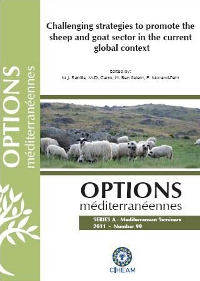| Article précédent | p. 355-360 | Article suivant |
Effect of the production system in the fatty acid profile of Payoya goat kids
The importance of organic livestock production is increasing in Spain and especially in Andalucía, but nevertheless still exist reduced number of studies about the quality of these products. The aim of this study was to evaluate the effect of management system (conventional vs organic) on the fatty acid profile (with special reference on the conjugated linoleic acids, CLA) in the meat of Payoya goat kids. Twenty-four male kids (12 from a farm with conventional system and 12 from a farm with organic system) were used. The farms were located in the Sierra Norte of Cádiz (Andalucía, Southern Spain) and were fed in a grazing-based management, ranging mainly between semi-extensive and semi-intensive systems. Kids in both groups were born from twin births. They were raised with natural milk and slaughtered at same average live weight (8.4±0.31 kg). After 24 hours of chilling, carcasses were splitted along the dorsal midline and Longissimus thoracis muscle was obtained, packed to the emptiness and preserved at -20ºC up to analysis. There were no significant differences in a high number of the studied fatty acids according to production system, except for C14:0, C18:1, C20:0, C21:0, and C22:5n3 (with higher percentage in organic kids, P<0.05) and of C15:1 and C18:0 (higher percentage in conventional kids, P<0.01). In relation to calculated indexes, organic kids have showed highest values in the 9C18 desaturase activity index and in atherogenicity index (P<0.05). In conclusion, no significant differences were found in the fatty acid composition of meat from kids raising in organic and conventional systems.
L'élevage biologique est de plus en plus important en Espagne et surtout en Andalousie, mais il existe un nombre réduit d'études sur la qualité des produits obtenus dans ce système et encore moins réalisées sur des races autochtones de chèvre comme la Payoya. L'objectif de cette étude a été d'évaluer l'effet du système d´élevage (biologique vs traditionnel) sur le profil des acides gras (avec une référence particulière aux acides linoléiques conjugués, CLA) de la viande des chevreaux de race Payoya. Vingt-quatre chevreaux mâles (12 animaux par système d'élevage) ont été utilisés. Les fermes se trouvaient dans la Sierra Norte de Cádiz (Andalousie, sud de l'Espagne) et l'alimentation provenait principalement de pâturages, entre semi-extensifs et semi-intensifs. Tous les chevreaux sont nés de mises bas gémellaires. Ils ont été élevés avec du lait et abattus à poids vif moyen de 8,4 ± 0,31 kg. Après 24 heures de refroidissement, les carcasses ont été découpées le long de la ligne médiane dorsale et le muscle Longissimus thoracis a été prélevé, emballé sous vide et conservé à -20 ºC jusqu'à l'analyse. Il n'y avait pas de différences significatives sur la plupart des acides gras étudiés en fonction du système de production, à l'exception du C14: 0, C18: 1, C20: 0, C21: 0 et C22: 5n3 (avec un pourcentage plus élevé chez les chevreaux biologiques, P <0,05) et du C15: 1 et C18: 0 (pourcentage plus élevé chez les chevreaux du système traditionnel, P<0,01). En ce qui concerne le calcul des différents index, les chevreaux biologiques ont présenté des valeurs plus élevées de l'index d'activité de 9C18 désaturase et de l'index d'atherogénicité (P<0,05). En conclusion, aucune différence significative n'a été trouvée dans la composition en acides gras de la viande provenant des chevreaux élevés dans les systèmes biologiques et conventionnels.
- [ Afficher ]
- [ Télécharger ]
- [ Exporter la citation ]
Vous pouvez télécharger la citation au format :
- [ Imprimer ]
-
Mots-clés
ACIDE GRAS, CHEVREAU, COMPOSITION CHIMIQUE, RACE INDIGENE, SYSTEME D'ELEVAGE, ELEVAGE BIOLOGIQUECiter cet article
Guzmán J.L., Zarazaga L.A., Celi I., Delgado-Pertiñez M. Effect of the production system in the fatty acid profile of Payoya goat kids. In : Ranilla M.J. (ed.), Carro M.D. (ed.), Ben Salem H. (ed.), Morand-Fehr P. (ed.). Challenging strategies to promote the sheep and goat sector in the current global context. Zaragoza : CIHEAM / CSIC / Universidad de León / FAO, 2011. p. 355-360. (Options Méditerranéennes : Série A. Séminaires Méditerranéens; n. 99). 13. International Seminar of the Sub-Network on Nutrition of the FAO-CIHEAM Inter-Regional Cooperative Research and Development Network on Sheep and Goats, 2009/10/14-16, León (Spain). http://om.ciheam.org/om/pdf/a99/00801579.pdf



